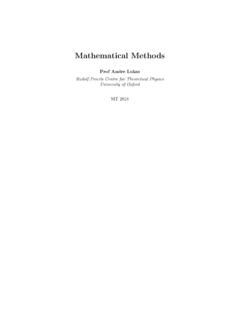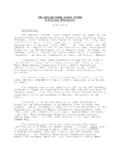Transcription of The Physics of Quantum Mechanics
1 The Physics of Quantum MechanicsJames BinneyandDavid SkinnerivThis book is a consequence of the vision and munificence ofWalter of Merton, who in 1264 launched something goodCopyrightc 2008 2013 James Binney and David SkinnerPublished by Cappella Archive 2008; revised printings 2009, 2010, 2011 ContentsPrefacex1 Probability and probability The laws of probability3 Expectation values Probability amplitudes5 Two-slit interference 6 Matter waves? Quantum states7 Quantum amplitudes and measurements 7 Complete sets of amplitudes 8 Dirac notation 9 Vector spaces and their adjoints 9 The energy rep-resentation 12 Orientation of a spin-half particle 12 Polarisation of photons Measurement15 Problems152 Operators.
2 Measurement and time Operators17 Functions of operators 20 Commutators Evolution in time21 Evolution of expectation values The position representation24 Hamiltonian of a particle 26 Wavefunction for welldefined momentum 27 The uncertainty principle 28 Dynamics of a free particle 29 Back to two-slit in-terference 31 Generalisation to three dimensions 31 Probability current 32 The virial theorem 33 Problems343 Harmonic oscillators and magnetic Stationary states of a harmonic Dynamics of oscillators41 Anharmonic oscillators Motion in a magnetic field45 Gauge transformations 46 Landau Levels 47 Displacement of the gyrocentre 49 Aharonov-Bohm ef-fect 51 Problems524 Transformations & Transforming kets58 Translating kets 59 Continuous transformationsviContentsand generators 60 The rotation operator 62 Discrete transformations 62 (a) The parity operator 62 Mirror operators Transformations of operators64 The parity operator 66 Mirror operators Symmetries and conservation The Heisenberg What is the essence of Quantum Mechanics ?
3 71 Problems735 Motion in step Square potential well75 Limiting cases 78 (a) Infinitely deep well 78 (b) Infinitely narrow well A pair of square wells79 Ammonia 81 The ammonia maser Scattering of free particles84 The scattering cross section 86 Tunnelling through apotential barrier 87 Scattering by a classically allowedregion 88 Resonant scattering 89 The Breit Wignercross section How applicable are our results? Summary98 Problems996 Composite Composite systems105 Collapse of the wavefunction 108 Operators for com-posite systems 109 Development of entanglement 110 Einstein Podolski Rosen experiment 111 Bell s inequality Quantum The density operator121 Reduced density operators 125 Shannon entropy Measurement132 Problems1357 Angular Eigenvalues ofJzandJ2139 Rotation spectra of diatomic molecules Orbital angular momentum145 Las the generator of circular translations 146 SpectraofL2andLz147 Orbital angular momentum eigenfunc-tions 147 Orbital angular momentum and parity 151 Orbital angular momentum and kinetic energy 151 Legendre polynomials Three-dimensional harmonic
4 Spin angular momentum158 Spin and orientation 159 Spin-half systems 161 TheStern Gerlach experiment 161 Spin-one systems 164 The classical limit 165 Precession in a magnetic field Addition of angular momenta169 Case of two spin-half systems 173 Case of spin one andspin half 174 The classical limit 175 Problems1768 Gross structure of hydrogen182 Emission-line spectra 186 Radial eigenfunctions 186 Shielding 190 Expectation values forr Fine structure and beyond193 Spin-orbit coupling 194 Hyperfine structure 197 Problems1999 Perturbation Time-independent perturbations203 Quadratic Stark effect 205 Linear Stark effect anddegenerate perturbation theory 206 Effect of an ex-ternal magnetic field 208 Paschen Back effect 210 Zeeman effect Variational Time-dependent perturbation theory213 Fermi golden rule 214 Radiative transition rates 215 Selection rules 219 Problems22010 Helium and the periodic Identical particles226 Generalisation to the case ofNidentical particles 227 Pauli exclusion principle 227 Electron pairs Gross structure of helium230 Gross structure from perturbation theory 231 Application of the variational principle to he-lium 232 Excited states of helium 233 Electronic configurations and spectroscopic terms 236 Spectrum of helium The periodic table237 From lithium to argon 237 The fourth and fifth peri-ods 241
5 Problems24211 Adiabatic Derivation of the adiabatic Application to kinetic Application to The compressibility of condensed Covalent bonding250 A model of a covalent bond 250 Molecular dynamics 252 Dissociation of molecules The WKBJ approximation253 Problems255viiiContents12 Scattering The scattering operator257 Perturbative treatment of the scattering operator The S-matrix261 Thei prescription 261 Expanding the S-matrix 263 The scattering amplitude Cross-sections and scattering experiments267 The optical theorem Scattering electrons off Partial wave expansions273 Scattering at low energy Resonant scattering278 Breit Wigner resonances 280 Radioactive decay 280 Problems282 AppendicesA The laws of probability285B Cartesian tensors286C Fourier series and transforms288D Operators in classical statistical mechanics289E Lie groups and Lie algebras291F The hidden symmetry of hydrogen292G Lorentz covariant equations294H Thomas precession297I Matrix elements for a dipole-dipole interaction299J Selection rule forj300K Restrictions on scattering potentials301 Index303 PrefaceThis book is the fruit of for many years teaching the introduction toquan-tum Mechanics to second-year students of Physics at Oxford University.
6 Wehave tried to convey to students that it is the use of probability amplitudesrather than probabilities that makes Quantum Mechanics the extraordinarything that it is, and to grasp that the theory s mathematical structure followsalmost inevitably from the concept of a probability amplitude. We havealsotried to explain how classical Mechanics emerges from Quantum Mechanics is about movement and change, while the strongempha-sis on stationary states in traditional Quantum courses makes thequantumworld seem static and irreconcilably different from the world of every-dayexperience and intuition. By stressing that stationary states aremerely thetool we use to solve the time-dependent Schr odinger equation, and presentingplenty of examples of how interference between stationary states gives riseto familiar dynamics, we have tried to pull the Quantum and classical worldsinto alignment, and to help students to extend their physical intuition intothe Quantum courses use only the position representation.
7 If you stepback from the position representation, it becomes easier to explainthat thefamiliar operators have a dual role: on the one hand they are repositories ofinformation about the physical characteristics of the associatedobservable,and on the other hand they are the generators of the fundamental symmetriesof space and time. These symmetries are crucial for, as we show already inChapter 4, they dictate the canonical commutation relations, from whichmuch advantage of down-playing the position representation isthat itbecomes more natural to solve eigenvalue problems by operator methods thanby invoking Frobenius method for solving differential equations in series. Acareful presentation of Frobenius method is both time-consuming and ratherdull.
8 The job is routinely bodged to the extent that it is only demonstratedthat in certain circumstances a series solutioncanbe found, whereas inquantum Mechanics we need assurance thatallsolutions can be found by thismethod, which is a priori implausible. We solve all the eigenvalue problemswe encounter by rigorous operator methods and dispense with solution introducing the angular momentum operators outside the positionrepresentation, we give them an existence independent of the orbital angular-momentum operators, and thus reduce the mystery that often surroundsspin. We have tried hard to be clear and rigorous in our discussions oftheconnection between a body s spin and its orientation, and the implications ofspin for exchange symmetry.
9 We treat hydrogen in fair detail, heliumat thelevel of gross structure only, and restrict our treatment of other atoms to anexplanation of how Quantum Mechanics explains the main trends of atomicproperties as one proceeds down the periodic table. Many-electron atomsare extremely complex systems that cannot be treated in a first course witha level of rigour with which we are theory is of enormous practical importance and raisessometricky conceptual questions. Chapter 5 on motion in one-dimensional steppotentials introduces many of the key concepts, such as the connection be-tween phase shifts and the scattering cross section and how and why inresonant scattering sensitive dependence of phases shifts on energy gives riseto sharp peaks in the scattering cross section.
10 In Chapter 12 we discuss fullythree-dimensional scattering in terms of the S-matrix and most branches of Physics it is impossible in a first course to bringstudents to the frontier of human understanding. We are fortunate in be-ing able to do this already in Chapter 6, which introduces entanglement andPrefacexiquantum computing, and closes with a discussion of the still unresolved prob-lem of measurement. Chapter 6 also demonstrates that thermodynamics isa straightforward consequence of Quantum Mechanics and that we no longerneed to derive the laws of thermodynamics through the traditional,rathersubtle, arguments about heat assume familiarity with complex numbers, including de Moivre stheorem, and familiarity with first-order linear ordinary differentialequa-tions.









